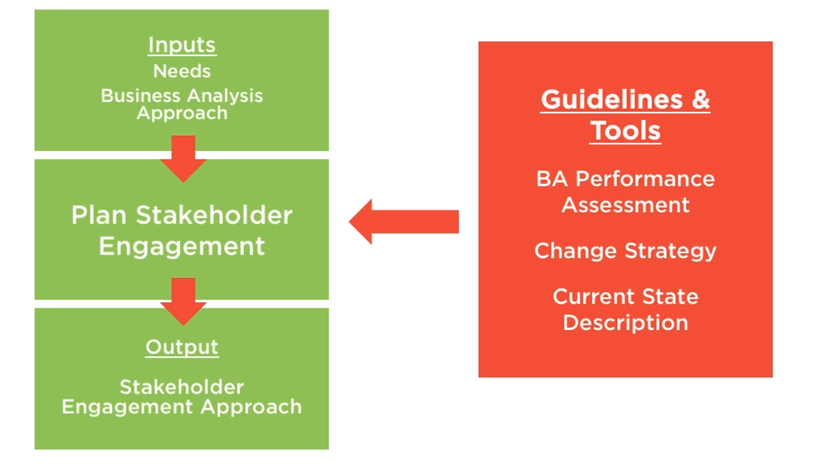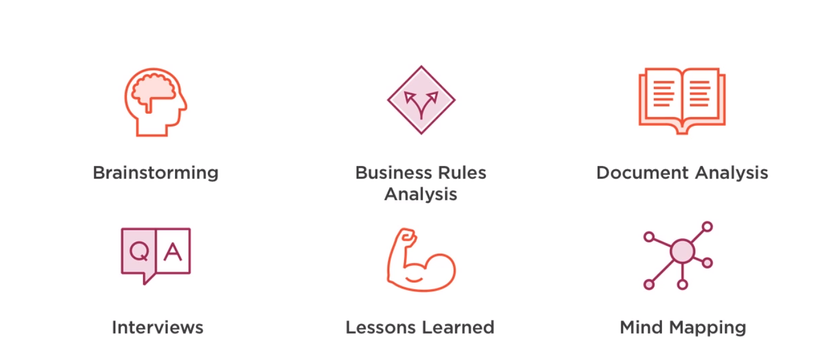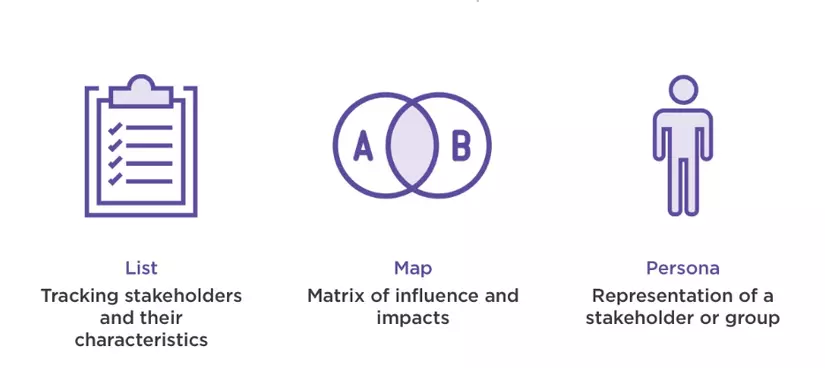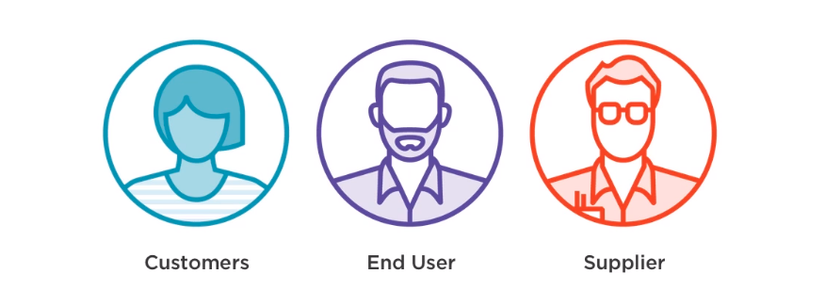Hello everyone, recently, I am learning about the related knowledge about BA, more specifically, I am learning through the book BABOK. Then in the last post I introduced about BA Approach, how to define planning approach, the complexity and risk in the define process. Guidelines, tools and techniques to help us build plan approach. And an important indispensable thing is the Stakeholders (stakeholders) – the people who help us to better understand domains and business. So today I want to introduce you to the identification and approach to Stakeholders.
In the BACCM model, we can see that ??????????? – roughly translated as Stakeholders, is one of 6 elements. This proves that this is an extremely important factor. Myself, stakeholder is also a base for me to apply for reasons
?- Finality: needs are multifaceted and sometimes limitless, but humans are finite. Identifying stakeholders is less likely to be deficient.
?- Ease of identification: For the same problem, a product, a system, different people will have the risk of having a different perception of needs, and sometimes the solution. Therefore, when we receive a request, the stakeholder as the initial step will easily get caught up in the questions of ambushing the request.
?- Relevance to life: needs, solutions may be intangible, tangible, but the stakeholder is human, but it is easy for people to observe, comment, and evaluate around life.
?- Multidimensional: stakeholder is very diverse, so the multi-dimensional problem assessment, a very important thing in the working process of BA, will be supported more and more clearly.
In the article I used the phrase Change effort , then I will explain this above. Change Effort or translated as “The motivation for change” is a term that refers to the motivation, there is any reason, there is any cause to drive the change in an organization or business or not. We can see some examples:
- Fall in revenue
- Cumbersome and blessed working process
- Work inefficient
- With IT-Tech, the form of technology is old, the trend is new
- N other reasons These things motivate us to change. Change to be better. But easy to say, quite difficult to do. The change requires quite a bit of Effort, from top to bottom to infrastructure
Planning Stakeholder Engagement Approach
… to plan an approach for establishing and maintaining effective working relationships with the establishing relationships
This sentence quoted in the BABOK Guide means that the purpose of Planning Stakeholder Engagement is to provide an approach to building and using relationships to help us make change effort possible. You will need to do a thorough analysis of who is the stakeholder and then focus on collaboration and communication with the stakeholder so that you can work with them in the most effective way. And then indentify the signals or risks that come up with the stakeholders, so you know how to approach any action that mitigates the risks involved in working with stakeholders. And you also have to consider more about the many stakeholders you have to work with, the more complex they are, the more effort you will have to work with them.
You should also consider the structure of Planning Stakeholder Engagement , and follow these steps

The first is Inputs , we need to understand the business needs and the parts of the business, the impact of which helps in indentify our stakeholders. This need can grow as the stakeholder analysis is done. Next is that we need to plan for participation between stakeholders, and collaboration and communication with these stakeholders are also very important. To do this you will probably need the guildeline and tools shown in the picture. And finally after all of the above we will have output for the Stakeholder Engagement Approach .
Stakeholder Analysis
We will go into Stakeholder analysis to help prepare you mentally and what to do before working with them.
First, you need to define which stakeholders you need to work with, you need to consider the individuals and groups that are directly and indirectly affected, their impact on your change effort .
Next is the characteristics of how they work, how their experience working with the previous BA, how their expert level and other things will affect the way you approach. they in Business Analysis .
And you have to do this process again and again when the stakeholder may change as the needs change . So you should always look at your Stakeholder lists and analyze which Stakeholders you need to work with.
The ways you approach Stakeholders include:
- Refer to organizational charts
- Look at the business process documentation
- Ask the sponsor to identify the Stakeholders and make sure
- From information that already exists in existing or future contracts
- The requirements and guidelines you have to follow, the people that set the requirements you should also be interested in
- Internal and external customers are also the people you refer to to determine the Stakeholder.
Identify Stakeholder roles to understand where and how Stakeholders will contribute to their initiatives. It is very important that the BA person is aware of the Stakeholder roles as well as organizational responsibilities.
Stakeholder’s views can positively or negatively influence a change. The BA person defines the Stakeholder’s views in order to fully understand what will influence a Stakeholder’s action and behavior. The BA people analyze Stakeholder’s views on the following:
- the business objectives, the goals of the initiative, and any proposed solutions.
- general professional analysis.
- level of change.
- sponsor.
- team members and other stakeholders.
- collaboration and team-based approach.
The BA person determines the Stakeholder’s level of authority in business analysis activities. And make sure you work with the right stakeholders when looking for a decision to embark on or seek approval of your idea.
Define Stakeholder Collaboration
Collaboration with Stakeholders is seen as core to maintaining their engagement for business analysis activities. The BA will plan different approaches to cooperation for the internal and external stakeholder, and these approaches will differ in business analytics activities. Some considerations when collaboration is planned:

- timing and frequency.
- location.
- Are there available tools such as wikis or online communities.
- Communication method like this: skype, google meet, …
- stakeholder preferences.
These plans can be documented. As factors change, the plan can be reviewed and adjusted, responses can be made to ensure the continued participation of the Stakeholders.
Stakeholder Communication Needs.

The BA person needs to calculate the following in the process of communicating with Stakeholder:
- What will be communicated with Stakeholder
- What is the appropriate method of exchange, for example, if a company does not use skype, or blocks all skype, we have to calculate using another to exchange.
- Who are we going to add to our conversation with Stakeholder
- When and where do I have this conversation
- Exchange how many times or to what extent is fine
- You pay attention to the geographical location so that you communicate with them it is suitable in terms of time and communicate in the most effective way.
Guidelines, Tool and Techniques

The following guildline will assist you in communicating with Stakeholder:
- Branstorming : identifying affected Stakeholders or influencers within a changing scope
- Business Rules Analysis : allows you to consider who helps your business rules affect your solution scope
- Document Analysis : You should always read through your organization’s documents to identify key Stakeholders to include in your analysis.
- Interviews : we can interview Stakeholders that are on the list we already discussed to find out what more Stakeholders we need to consider.
- Lessons Learned : is used to identify previous organization’s experience in planning conversations with Stakeholder, and will of course avoid mistakes made in previous attempts.
- Mind mapping : is a visual technique for brainstorming not only the Stakeholders included in the scope, but also their relationships.
- Organizational Modeling : This helps you to understand the Stakeholder interactions, to indentify more relevant Stakeholders.
- Process Modeling : Very useful for looking at business processes, sorting Stakeholders
- Risk Analysis & Management : when you indentify key Stakeholders and discuss their ability to participate in change effort, or their views on change effort.
- Scope Modeling : used to develop scope models to show Stakeholders that they can stay out of the scope of the solution we are given but still need to interact in some way.
- Survey or Questionnaire : is used to determine the characteristics of separate Stakeholder groups
- Workshops : help us interact with Stakeholder groups, get a lot of information about Stakeholder groups and their functions help us in the working process.
Stakeholder List, Map, or Persona :
- Use List to determine who are the Stakeholders, but this is also a place to track their features.
- Using map so we can plan what influences the Stakeholders and how are they then subjected to this change effort interaction? Because the greater the influence on them, the more we want to include them in order to give a reasonable solution, both doing our job and not affecting them. And the larger the impact, the more demanding management is required.
- Persona: we can talk about factors such as personality, habits, culture, etc. These will affect the scope of stakeholder options as well as these factors are also the basis for you to declare. extract relevant information, configure the user story of the product, and configure the output of the product.

Understanding Stakeholder
The concept of “Stakeholder”, as was defined at the outset, is “Stakeholder stakeholder”. Just looking on wikipedia there are more than 20 types of Stakeholders. This time we will take a look at the most popular and closely related Stakeholders to our business. Furthermore, Stakeholder can be classified into two categories as below. The content to explain these two types of Stakeholder is as follows:
- Direct Stakeholder: Direct Stakeholder. Are the people who have a clear role in the target service as well as in the organization. In addition, they are also individuals or communities that use the service in practice and are affected by that service.
- Indirect Stakeholder: Indirect Stakeholder. These are the people interested in improving the quality and problems of the target service.

Any Stakeholder should not be ignored, whether direct or indirect, more or less influential. Each Stakeholder will give you different information and perspectives and these are all valuable
In terms of thinking about the Stakeholders you’ll need to work with your change effort, it’s the easiest way to get started with customers, these are the external users of the solution. And the end users, usually the internal customers of the solution. Besides, you should also think and consider what Supplier need to be for both creating and supporting the last solution of change effort.

Domain Subject Matter Expert is often needed throughout the change effort for the affected areas, just as they can suggest other Stakeholders for business analysis.
Project Manager : the people who understand the project best, they also manage which relevant Stakeholders are needed for their project overview.
Regulators : are also objects that you need to care about, bringing the change efforts made in the legal factory or the processes.
Sponsor : Sponsor are the specific Stakeholders of interest.
Creating a Stakeholder Engagement Approach
For example we have a change effort as follows: Thay thế server hiện tại bằng server khác Assuming that:
- This server has been replaced before, it supports customer-facing application
- We already have expert experience in the company that can support the team in this transformation
- Dev does not make this product much change
- The organization size is average, team dev is the same, no one is onsite or remote
So the Stakeholder Engagement approach includes:
- List the Stakeholders, define their roles, and their responsibilities for the change effort. That includes IT subjects like IT subject matter expert, project manager, sponsor, and people like those working in finance departments (If our app has data affecting their side). It could also be the customer.
- Once we have listed the Stakeholders in the above list then we have to make sure we either understand each person or their role connecting with the change effort. And how can they interact with the solution, especially those who can make decisions that change the requirement, solution scope.
- And we’re going to have to do some persona to connect the characteristics of these Stakeholders, and do some more process mapping to understand how the changes will appear like removing this Stakeholder, adding another Stakeholder, depending on our needs and the way our analysis we get rid of, we need to focus on the key Stakeholder to help us come up with the solution.
- Any communication plan with them needs to be included here, when it will match and how they will communicate with business analysis requirement and test plans.
- As well as clearly defining the needs of the dev team to communicate any decisions, or issue status will affect the business analysis work.
- The cooperation plan between the parties is also very important. Once we were planning all the teams would work together at the workshops, so we could define all the requirements.
- And you see where your organization or store the data after each discussion where such as driver, this will help the project team review the requirements that we have defined, test. plan, documentation whenever needed.
Inconclusion
So through Stakeholder Engagement Approach , we need to do the following:
- Determine the Stakeholder list that is interacting with the change we are making
- An indispensable job in analysis is to have a characteristic analysis of the Stakeholders
- Definition, defines the roles and responsibilities for this change effort
- The approach will be the outline for planning to communicate with Stakeholders for business analysis information
- How do you plan for partnerships between stakeholder solutions that can be more motivating and valuable
Reference
IIBA BABOK v3
